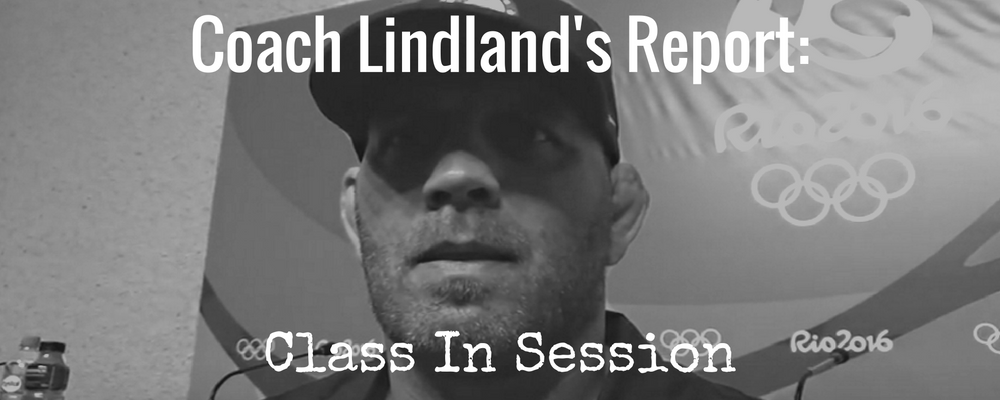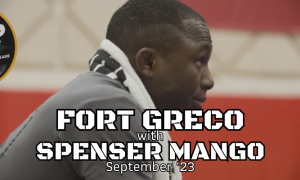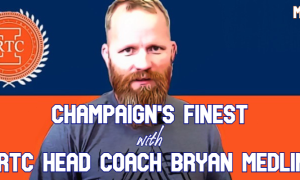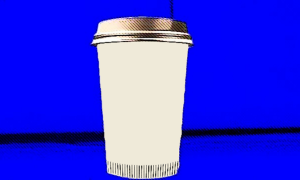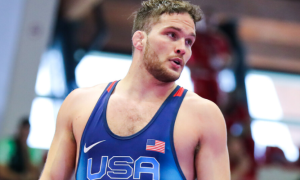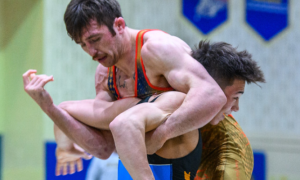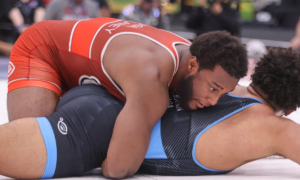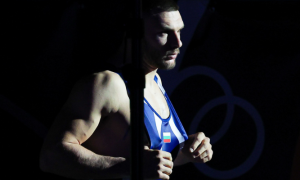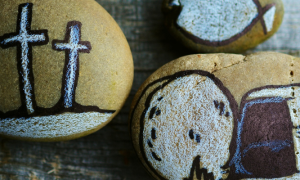Five Point Move is proud to host US Greco Roman National Team Head Coach Matt Lindland every week for “Coach Lindland’s Report.” For fans and wrestlers looking for insights regarding the US Greco National Team, we ask Coach Lindland some questions to get his take on training and upcoming competitions. If you have any questions you’d like us to ask going forward let us know via Facebook, Twitter, or through our Contact page.
Following last week’s Coach Lindland’s Report, conversation online and on social media began to revolve around the prospect of coaches’ education videos. It makes sense — with a growing need for more Greco Roman coaches in the country, those who might want to be involved would like instructional measures so they can be brought up to speed. That is a primary topic this time around. Also, Coach Lindland touches on misconceptions regarding the US program’s inclusiveness and the steps he has personally taken to make sure college wrestlers and coaches understand they have all of the necessary avenues required to participate. In addition, clinics and teaching young Greco wrestlers are part of the discussion, as well.
5PM: Last week’s report kicked off a lot of chatter from coaches around the country. You brought up the new plan regarding empowering elite regional Greco coaches. Well now, there are coaches from other areas of the US who would like to get on board so they can learn to teach Greco. These guys have voiced a desire for video instructionals, whether that means videos streaming online, live feeds, or videos being uploaded so they can get them whenever they want. How do you feel about this and where can you see a process like this going?
Coach Matt Lindland: First of all, I think it’s super-exciting that there are a lot of coaches out there who are not only following what we are doing here on Five Point Move and reading the reports and understanding that yeah, there is a plan going forward to work on coaches education and the development of coaches. Because without having elite coaches across the country, it’s hard to develop elite athletes. So I think first and foremost, the plan we talked about in last week’s report, which is breaking down the country into regions and really using the guys out there who are knowledgeable, the guys out there who are in those regions, have experience in Greco and are currently coaching Greco, and we’ve got some guys who are exclusively coaching Greco. There was a lot of chatter about footage and videos. I get questions all the time, Where can I watch videos? And there’s not a ton of stuff, even up on the Coach Matt Lindland YouTube channel yet. This got me thinking: I was at practice when I was reading those comments, so I handed my iPhone off and said to (coaches) Momir and Mohammad, “We’re all teaching today.” We are in that time in the season where we’ve got young guys in our room, it’s a fresh quad, I’ve got 18, 19, and 20-year old guys in the room who still need to learn Greco. So we broke out the iPhone and you know what, I’ll just get that stuff up on my YouTube channel for now.
But moving forward, you’re asking a question about a system and yes, we have to develop some kind of system. And I think we can do it with Five Point Move, we can host the content here somehow. But it can’t just coming from the national office, I think it also needs to come from the community because there are some outstanding Greco coaches out there who are doing things differently than I do them, and maybe I am going to get an opportunity to learn something as well from seeing what other people are doing. We can get the battle light going, we can create the discussions and we can start talking about philosophy. You know, when I’m teaching to the athletes in my room, I’m really thinking about when I teach that, This is how I do it; this isn’t how I expect YOU to do it. And I think that is different from how a lot of these athletes are used to being coached. It’s kind of like, Here’s how to do this move – put your hand there, put your foot there, grab the hips, whatever the technique is you’re showing.
What I like to emphasize are the principles, how something works, what makes it work, the theories behind it, and I like to see the athletes become the artists that they are and create this technique in their image and develop something different. In this first series you’ll see that Momir, Mohammad, and myself send out, we do three things. We do arm-throws, and I do something different with them. For me, there are three different types — there is a torquing motion, there is a lifting motion, and then there is one where you take out an opponent’s center of gravity. And from there, once you understand those three concepts and principles, when you hit an arm-throw you are going to use bits and pieces of those principles, but it is going to be your own move.
Then we all showed bodylocks and we got to the sagging bodylock. It’s so interesting and you’ll see when this footage comes out. I’ll get this up, I might not be the most tech-savvy guy in the world, Tim, but I can upload a video to YouTube. It was shot on an iPhone, so it might be pretty raw. But what you’ll notice is that each one of us does the technique differently (laughs). Three different ways to do the same move. The principles never change, though, which is what is really fascinating. We had Mohammad showing how he attacks his sag bodylock. And then I came in and showed one little piece of what I do, and the Momir came in and showed what he does. They were all different, but they were all fundamentally the same, and that was fun to see.
I believe there is a lot of opportunity to get the community involved and moving forward, we’ll figure out what platforms we could use or whether or not we’re going to live stream stuff at certain times. There are so many smart coaches in the community, so let’s start this dialogue now and figure out what the best usage is. USA Wrestling is a volunteer organization and there is only so much work I can do, you can do, Tim, so we need to find some guys out there who are interested in being a part of this. I’m sure there are people out there who are reading these Weekly Reports and are involved in our sport who want to get involved and maybe this is an area where they can reach out to me and we can put them to use.
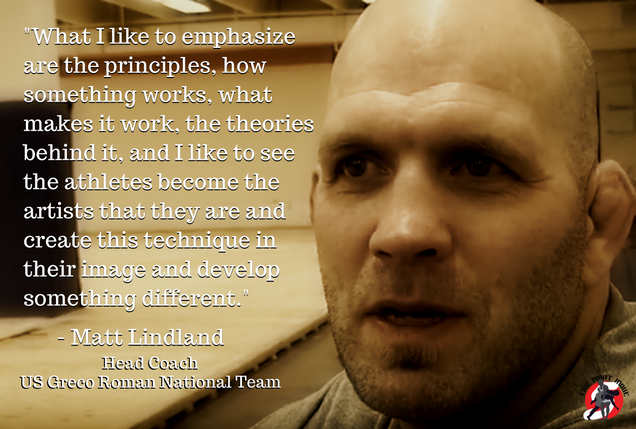
5PM: You have mentioned previously at some point that there is a difference between teaching to athletes and teaching to coaches. If there are educational videos for coaches coming from you, would you potentially be holding whiteboard sessions and discussing like you said, philosophical suggestions such as how to run practices and talk to athletes? Or is this just as much of a grassroots thing, as in “If you are new and don’t know how to teach Greco, this is how to go about it?”
ML: Well I think right now, it is about that. A lot of the questions I’ve been getting start out with, I don’t know how to teach Greco. (Laughs) That’s kind of been the hold-up. When there is a question about why can’t we get more athletes involved, the answer often is, Well I don’t know how to teach it. I think the other answer that we don’t hear is, I’m afraid to teach it because I don’t know. But it’s the guys who are saying, I don’t know, but if I knew, I would be comfortable teaching this. So the first step is certainly to get as much teaching content as we can and start rolling it out on a weekly basis. Time is the only factor that limits us from doing that. When I’m teaching, I can just hand one of the guys who is icing his knee on the side the iPhone. That is not the hard part. It’s downloading the video, uploading it, posting it, sharing it, and getting it out there. If we can find a centralized location like Five Point Move, that makes the most sense right now.
There is so much good stuff out there and so many coaches to learn from about planning a practice and planning a season, sports psychology. As a coach, especially as a club coach, you’re doing all of those pieces. Even as the National Coach, you’re a part-time sports psychologist. But I do have the luxury of quality volunteers who have been in that field for over 40 years and are experts in that area, and now they’re coaching NASCAR athletes.You have to have all of those things and certainly, the education will flow from whatever is being requested. I think if there is a request and someone wants to be educated and asks a question, we’ll put something out related to their question. I want to serve the wrestling community, especially if they are willing to coach Greco Roman athletes, get them into competition, and help us build our program into one of the best in the world, which I know we can do that. It is just going to take that 3% and we’re not even close yet. So we have to build.
5PM: You are going to be hitting the road doing some clinics coming up, isn’t that right?
ML: I’ve got a few fall clinics I’m doing this year. People are chattering on the internet, sure, but I’m also getting calls asking me to come out to New Jersey, Indiana, other places. I’m also going out to the Alan and Gloria Rice Hall of Fame in Minnesota. There is just a lot of stuff going this fall with the clinics, Hall of Fame banquets, and I’m actually squeezing in a trip to Costa Rica next week. It’s our 25th wedding anniversary and my wife and I have never taken a vacation that didn’t involve fighting or mixed martial arts, so it’s time to do that, for sure. But all of these things will come together. Like I said, it’s getting the clinics, getting the content, getting it out there and sharing it — that’s what it is going to take right now.
5PM: Do you have dates for any of the clinics that are coming up?
ML: I am teaching in Indiana on October 21st, but I’m getting in on the 20th. Though, I might be teaching both days. I have the Hall of the Fame on the 22nd, but I will get back to you with the exact dates and more information in another report. Even in the springtime, I’ve got guys hitting me up already saying, Hey, as soon as folkstyle is over I want to get you out here, so I’m getting locked in. And some of these are coming together now in the fall and we’re starting to schedule them for the springtime. This folkstyle thing seems to always get in our way though, doesn’t it?
5PM: That actually kind of leads into something sort of off-topic that I wanted to bring up. Obviously, we have been discussing folkstyle’s place in our country for quite a bit now and you know, it occurred to me that folkstyle isn’t really the problem, it’s the lack of choice. I’m sure this isn’t an original thought, but we don’t even have it set up to where kids could even really try wrestling competitively in Greco or freestyle during the fall and winter. There is folkstyle season, and then there is whatever happens after that. So there isn’t even the opportunity or choice to build momentum coming off of summer wrestling. This actually, to me, seems like the real problem, or am I too much of an idealist?
Coach Matt Lindland: No, I don’t think it’s too idealist of a question or assumption to make. If you were anywhere in Europe, that would be your choice, freestyle or Greco, and it would usually be in the same tournament. But here, there is a third option and you’re right, it completely dominates a majority of the year in the United States. Fortunately, Jay Eide, who is one of the big event coordinators out here in Colorado, said he is willing to experiment even if it’s going to cost him money. Here in Colorado, every month there is a Greco tournament. There might be a folkstyle tournament every week, but every month they are going to host one Greco tournament. And they have plenty folkstyle events weekly to market those, too, so I think there’s a chance that we can at least see some interest at the kids and schoolboy ages.
5PM: Okay getting back to the coaching and clinics aspect of things, when you teach at a clinic and you’re in a room full of wrestlers new to Greco Roman, is there a baseline of ground zero you focus on starting these younger athletes from? A base approach you feel is developmentally important to start with?
ML: To me, it comes down to having the body in the right position before you can start to manipulate and control someone else’s body. You have to learn to control your own body first. So if you are bent over too far, your center of gravity is off, you are off balance. It’s about teaching these young athletes to lower their stances properly and how to get their centers of gravity underneath them, and how to hold those positions when wrestling. Once they understand what balance is and where their centers of gravity are, you can start to teach them how to break their opponents’ balance. And from breaking your opponent’s balance, all of your attacks can come off of those because they are out of position. And if you can get your opponent out of position, that creates an opportunity for you to score and the attacks are the attacks. Like you were saying, they know moves. They have been taught moves, they know duck-under’s and arm drags, and slide-by’s. So the moves are there.
I think one of the biggest misconceptions is that every time you want to penetrate and get to your opponent’s body. Athletes who come from a traditional folkstyle background tend to move their opponents away an equal distance and then try to close. They don’t know how to close that distance properly. So the first thing you do is show them how to get their centers of gravity underneath themselves and hold their positions. Then you teach them how to break their opponents’ centers of gravity. And then once those breaks happen, they create scoring opportunities and they are able to capitalize, they can take the attacks.
The two biggest skills lacking in pretty much every wrestling room in the country are the back-step and the back arch. You can teach those in such a short time. I can have kids throwing full bodylocks in under 20 minutes and we’re talking about guys who have never thrown before, they’ve never experienced a back arch. But there is some fear there, too, and you have to get them to overcome that fear. That comes from particular drills that you do and you start by wall walks and partner-arching drills where you start to realize that, I’m actually safe if I extend my hips to the ceiling when I arch, I’m not going to land flat on my back or straight on my head. Just teaching those kinds of fundamentals gets the athletes excited over all of the opportunities that come from there. Because if you’re missing the back-step and the back arch, you are missing a lot of wrestling. You’re missing all of the fun parts of wrestling, which is throwing your opponent (laughs).
5PM: Switching gears, last week on the World Wrestling Resource podcast with Dennis Hall, Terry Brands, and Jason Bryant, Brands kind of intimated that there has been a lack of communication between the national office, which means you…
ML: (Laughs) Thanks for letting me know that. And I think Dennis and Terry made some really good points in that podcast and you should probably put a link to it and give Jason some love, but yeah, they had some really good ideas, and they are all things we are currently doing.
5PM: One of which is trying to welcome the collegians in.
ML: Well from Terry’s standpoint, it is engaging the college coaches. He said that the national office, which as you pointed out is me, is not making an effort to get college athletes involved in the sport. That our procedures aren’t inclusive enough, not open enough for athletes, we’re not making the calls, emailing, texting, trying to get a hold of the college coaches to get their athletes to training center. I think that is pretty ironic when Terry is certainly one of the coaches I would reach out to, he has some incredible guys who have been on our National and World teams. He has Sam Stoll, he’s got guys who have won Fargo in his room. I sent him an email and it was a couple of weeks before the NCAA’s and I know that the coaches are busy that time of year. So I said, Hey, if you could get back to me in the next couple of weeks. I think it was around March 8th and I said by the 25th, if he could get back to me and let me know. How, Not only do I have beds and a camp going on, but I have some that are funded. Especially for a guy like Stoll, who has been on the World Team for us, or even for some of his guys who have won Fargo titles. And then I said that the camp is not till May and how consequently, it worked out for the athletes. They were right out of school.
I was very clear on the athletes, I mentioned guys like Stoll, Brooks, Gunther, Burak, Paddock, Turk, I mentioned guys I would specifically like to get out here. So when he is saying stuff like, The national office isn’t reaching out, that’s entirely inaccurate. I’ve reached out to a lot of the guys, and some of the coaches have got guys out there. Iowa State had four guys in the room, George Mason had a couple of guys in the room. There are guys who are doing this. I think the perception is that Terry Brands was saying the national office was not making an effort, we’re not trying to get guys out there. Yes, I do believe I want the same athletes that they do, the young 18-20 year-old guys. I mean, we’re going after the same athletes, I just want them to compete in Greco and they want them to compete in folkstyle. But it certainly doesn’t mean that the guys who are competing in folkstyle I don’t want to compete in Greco, because I sure do. They have some of the “blue chippers”, the top guys in the country, guys who are already proven performers. Like I said, Stoll was on World teams for us and I think he can be one of our top heavyweights at the Senior level once he gets healthy. He did blow out his knee last year and so he wasn’t able to wrestle in any of the Greco stuff.
But we are doing those things, I think we are reaching out. I know Joe Russell and Teague Moore put a lot of work and a lot of effort into this new event called the College Greco Duals. 24 teams came out and participated in the freestyle portion and four participated in the Greco Roman. And you know, Iowa wasn’t one of those four teams, so maybe this year coming up they will be the fifth team or sixth team. I don’t know, I hope this grows. I know that Joe Russell and Teague Moore are committed to promoting both international styles and still having competitions in both. My challenge to college coaches is to get your guys out there, get them out of their comfort zones. Maybe they are uncomfortable wrestling Greco. Great, get them out of their comfort zones and help them become better wrestlers and athletes by attempting it. But when you have coaches who come up afterwards and say, Man, I wish this was a two-day event, a guy like Teague says, It is a two-day event, you opted out of the second day with Greco Roman. It makes me happy that I do have some coaches out there who are supporting it. It also makes me happy that Terry says he does want his guys wrestling Greco. Now I just have to call him, text him, I don’t know what the best way to get a hold of him is, but I will find that out and make sure that his athletes are invited to every camp, as well as all of the other college athletes around the country. They are all welcome to attend our camps.
I think that leads us into kind of the last thing for this week’s report, and that is, we did get our Trials procedures approved by the Greco Roman sports committee this past week on Thursday night. We had a call and we finalized the Trials procedures that are going to take place the weekend of November 11th and 12th at the New York AC/Bill Farell tournament. We will have our two non-Olympic weights contested for the World Team Trials. And then moving forward, when we have our 2017 World Team Trials, I talked to a lot of coaches and just got some feedback about what the theme was and what we want to try to do, which was all about what Terry was saying and that is being more inclusive to the college coaches.
In 2014, the Trials were a month later than the freestyle, which is not what I want. I want them sooner rather than later so we have more time to prepare and train the guys who are going to compete in the World Championships. But Steve did that to encourage the freestyle guys to come and change over, and we already saw that didn’t work. We only had three guys and two of them were pretty much Greco guys, Sam Hazewinkel and JD Bergman, and then Trice came over. But since then, two of those guys have retired from the sport but we’ll see where Sam is. I know he took a new job at Central Oklahoma, so I don’t know what his training situation is going to be but last time we talked, he said he was going another quad. Which doesn’t surprise me because he’s a warrior.
5PM: Yeah, he’s a rare breed.
ML: He certainly is.
5PM: What has been the general response from those on your side of the fence, be it athletes or coaches?
ML: The response I got from our Greco guys was to open this up and see how many guys want to come over. How many guys want to take a leap and give Greco Roman a try? Because they have an opportunity to wrestle in our World Team Trials if they are an NCAA qualifier. I think that is pretty “open.” I think that is showing anybody who is at a level where they can qualify for the NCAA’s, they are welcome to come participate at our Trials. And then we went to the DII’s, DIII’s, NAIA, and the junior colleges and said anybody who was an All-American there could be welcomed. The NWCA, we haven’t finalized yet, but I even had some of those guys call me up after saying that maybe we should invite some of the finalists from the NWCA.
So I think what you are seeing, not just from the national office, but from the entire Greco Roman community, is that we’re saying, “Hey, you guys are welcome to come over and jump into the pool and see how you swim.” We’re all trying to do the same thing, which is become the best team in the world and we need some more athletes over here. And I don’t think any of the guys who are currently in our pool of athletes are discouraging this by any means. So I think we’re headed in the right direction, Tim. What are your thoughts?
5PM: My thoughts are aligned with yours in that you have a gate you have given everyone a key to walk through it if they so choose. And if they do, there is no time better than now to do so. There is not going to be another “best” time in their lives if they are willing to give it a shot. If there are athletes who have always wanted to try Greco but were afraid, now is the best time.
Coach Matt Lindland: I also think it’s the best time because the rules have changed and potentially, that could help guys who haven’t spent time working their par terre defense. Which is an area the Americans have typically had trouble with. The only other way you’re going to get a chance to turn somebody is if you take him down. If you’re a college wrestler and you’re good at getting people to the ground, then well, you’re right Tim, there is no better time to come out and jump in the pool.
Be sure to follow Coach Matt Lindland on Facebook, Twitter, and his official blog for updates on the US Greco Roman Wrestling program heading into the new competitive cycle.
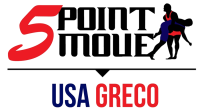
Notice: Trying to get property 'term_id' of non-object in /home/fivepointwp/webapps/fivepointwp/wp-content/themes/flex-mag/functions.php on line 999

